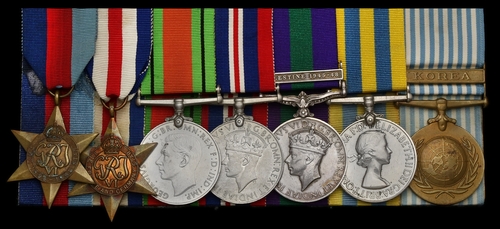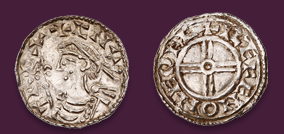
Auction: 25002 - Orders, Decorations and Medals
Lot: 47
A Second World War and Korea group of seven to Private G. Miller, King's Own Scottish Borderers, who was wounded in action at the capture of Walcheren Island on 4 November 1944 and after leaving the army rejoined to serve in Korea, where he was wounded again on 4 November 1951 during the Second Battle of Maryang-sa - the same action in which 'Bill' Speakman won his his Victoria Cross
1939-45 Star; France and Germany Star; Defence & War Medals 1939-45; General Service 1918-62, 1 clasp, Palestine 1945-48 (3188826 Sjt. G. Miller. K.O.S.B.); Korea 1950-53 (3188826 Pte. G. Miller. K.O.S.B.); United Nations Medal for Korea, light contact marks, otherwise very fine (7)
George Miller was wounded on 4 November 1944 whilst serving with the 5th Battalion King's Own Scottish Borderers during the assault on Walcheren Island in Operation Infatuate (War Office Casualty List number 1612 TNA WO417/85 refers), and again on 4 November 1951 in Korea during the Second Battle of Maryang-san, on the ridge known as Hill 217 in Marysang-san.
The 5th Battalion King's Own Scottish Borderers (KOSB) commanded by Lieutenant-Colonel William F.R. Turner had landed in Flushing on 1 November at 17:00 and had settled down near the Arsenaal. That night, A Batt, O Group received its marching orders for the next day. A and C Company were ordered to advance through the positions of 4th KOSB by way of Betje Wolfplein and enter the areas code named Grouse and Cod.
At 05:00 they started their advance with A Company in the lead followed by C Company; the latter was soon subjected to German mortar fire which caused many casualties including its commander. A fortification in the quay wall of the Spuikom turned out to be the source of this fire. One of the howitzers of 452nd Mountain Battery was called upon to help solve this problem. As its indirect fire was hardly effective, the entire gum was dismantled and taken to the sleeping room of a house with a view on the bunker. It was reassembled in 20 minutes and after eight rounds, the Germans left the bunker and retreated in the direction of Hotel Britannia.
Around noon, 5th KOSB had achieved its goal, enabling B and D Company to strike towards the Kanaal door Walcheren past the shipyard and the Binnnenhaven. The area of the shipyard turned out to be an obstacle in its own right. In the entire harbor area, the Germans had erected fortifications and where the Kriegsmarine personnel had been driven from their positions, they fought like infantry. Snipers were firing from the cranes and could only be driven off with difficulty. Here again, the guns of the 452nd Mountain Battery were deployed to drive the snipers out. Towards nightfall, these two companies had reached their objectives as well. B Company had taken up positions near the Keersluisbrug across the canal and D Company was on their right flank in the shipyard.
On 3 November, 5th KOSB had their work cut out for them, clearing the various smaller German resistance nests in the eastern part of Flushing. Supported by artillery and Hawker Typhoon fighter bombers, the German fortifications were cleared one by one until sufficient ground was gained to attempt a crossing of the Kanaal door Walcheren. In the early morning of 4 November, B and D Company opened the attack by crossing the canal. B Company secured the left flank to the north, capturing the railway shunting yard in the process and a German fortification in the vicinity. With this, the northern flank was secured. D Company penetrated the area of the Binnenhaven, capturing the positions code named Haymarket and Strand. Subsequently, they advanced towards the railway station. Towards 05:30, all units had captured their objectives. C Company subsequently moved through the positions of B and D Company in order to take on the fortifications around the Buitenhaven. Resistance here was much stronger, partly due to the presence of strong German coastal batteries. Later that day, A Company took over the attack from C Company and entered the eastern port area of the Buitenhaven. Meanwhile, B Company advanced northwards along the railway line in order to find out which German fortifications were located in the direction of Oost Souburg. The surrounding area was flooded but the railway line and the dykes of the canal rose above the water. On 4 November, 5th KOSB had reached all its goals. The unit suffered nine deaths and fifty-three injured. 4th KOSB, which had mainly been busy clearing various resistance points in Flushing after its performance on November 1, suffered 10 deaths and 65 injured. The number of German victims is unknown but 5th KOSB counted over 400 prisoners of war.
The 1st Battalion King's Own Scottish Borderers War Diary TNA WO281/485 records Private Miller wounded in action 4 November 1951, shrapnel wound to foot, in the same action in which Private William Speakman 1st Battalion King's Own Scottish Borderers won the Victoria Cross. He was admitted 60 (Indian) Parachute Field Ambulance, transferred to 8055 Mobile Army Surgical Hospital (MASH) then admitted 29 General Hospital. He was reported as wounded in The Times on 17 November 1951.
In April 1951, the 1st KOSB was sent from Hong Kong to join the UN forces in Korea, arriving at Inchon on 23 April 1951. The Borderers went into action immediately on reaching the front, but almost right away began a withdrawal, along with the whole UN force. The Borderers were part of the Commonwealth Division that adopted a sector on the Imjin River, along the 38th Parallel, and firm defensive positions were immediately established. In Late September, there was a general advance by the UN and on 3 October, the KOSB fought a battle to gain possession of Hill 355. A new line was set up and was frequently attacked for the remainder of October.
On 4 November, the Chinese launched their 'Gunpowder Plot' offensive against the KOSB's positions with 6,000 men. During this battle Private Speakman won the VC and the enemy's attack failed, costing the Chinese more than 1,000 dead, while the borderers had 7 killed, 87 wounded and 44 missing. After this battle, the Borderers were withdrawn and moved to another sector. They left Korea in August 1952.
Subject to 20% VAT on Buyer’s Premium. For more information please view Terms and Conditions for Buyers.
Sold for
£480
Starting price
£240




